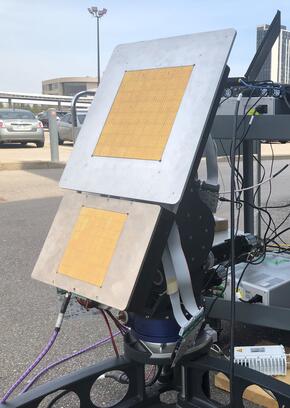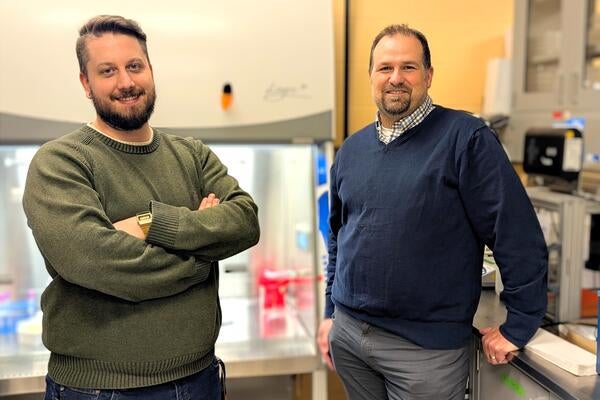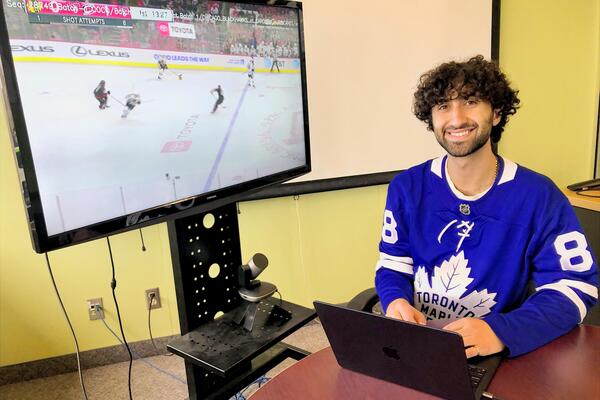
New tech passes the test
Waterloo Engineering research team marks major milestone in intelligent antenna project

Waterloo Engineering research team marks major milestone in intelligent antenna project
By Brian Caldwell Faculty of EngineeringAn intelligent antenna developed by researchers at Waterloo Engineering has been successfully tested, a major milestone in a multi-year, multi-million-dollar project.
The phased array antenna system for next-generation communications can be electronically steered to maintain links to overhead satellites for Internet connectivity.
“This modular, intelligent technology platform provides a cost-effective solution for a wide range of applications — from fixed to mobility satellite broadband services, and for the rapidly emerging millimeter-wave 5G cellular services,” said Safieddin (Ali) Safavi-Naeini, director of the Centre for Intelligent Antenna and Radio Systems (CIARS) at Waterloo.

Receiver (top) and transmitter antennas developed by Waterloo Engineering researchers are shown during recent testing.
The breakthrough was announced this week by C-COM Satellite Systems, a leading provider of mobile satellite antenna systems that is jointly funding the research with the Natural Sciences and Engineering Research Council (NSERC) of Canada.
Operating on the Ka-band, the low-cost technology was used in tests to stream video, surf the Internet, perform speed tests and conduct an uninterrupted video conference over Webex.
C-COM, which is based in Ottawa, was co-founded by Leslie Klein, a Waterloo Engineering alumnus who serves as president and CEO.
Safavi-Naeini has been working on intelligent antenna systems for satellite-based Internet connectivity for almost two and a half decades, motivated by their potential to deliver broadband service via satellite to moving vehicles and bridge the digital divide by extending the reach of broadband Internet to vast areas of the world that lack access.
“Measured over-the-air results have demonstrated the high performance of the compact, scalable antenna modules and validated our modular technology architecture for larger panels,” he said.
Successful initial tests over the Telesat Anik F3 satellite are a significant development for C-COM and CIARS. Researchers will now continue testing over several different satellites to confirm interoperability of the new antenna and radio system.
“Today, we are much closer to achieving our objective of delivering an affordable, electronically steerable antenna system capable of operating over the latest constellations of LEO, MEO and GEO satellites, which will play a significant role in delivering broadband solutions to consumer and enterprise markets worldwide,” Klein said in a media release.
Planning for commercialization of the new technology has begun, along with prototyping of a 4,000-element antenna using the same building blocks as the 1,000-element antenna that was successfully tested.
Main photo: Researchers (left to right) Naimeh Ghafarian, Ehsan Haj Mirza Alian and Wael M. Abdel-Wahab during testing of new intelligent antennas.

Read more
Engineering researchers team up to tackle the plastics pollution problem with microbial innovation and engineering design

Read more
15 University of Waterloo researchers have been named to the annual Highly Cited Researchers™ list for significant contributions to their specific fields of research

University of Waterloo Engineering master's student Liam Salass developed an AI-based system that improved puck detection when analyzing game video. (University of Waterloo)
Read more
University of Waterloo researchers make big strides in hockey analysis using game video
The University of Waterloo acknowledges that much of our work takes place on the traditional territory of the Neutral, Anishinaabeg, and Haudenosaunee peoples. Our main campus is situated on the Haldimand Tract, the land granted to the Six Nations that includes six miles on each side of the Grand River. Our active work toward reconciliation takes place across our campuses through research, learning, teaching, and community building, and is co-ordinated within the Office of Indigenous Relations.